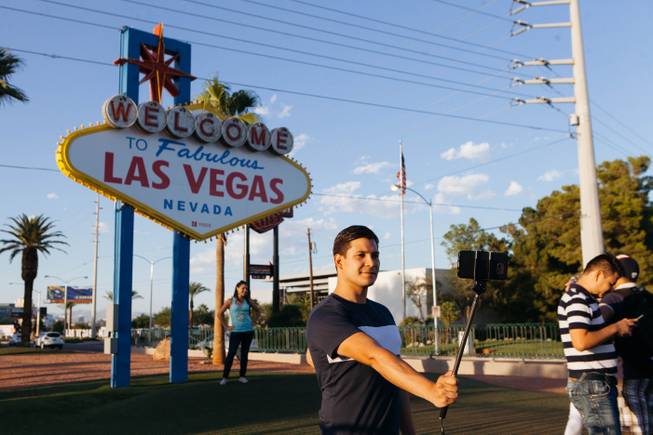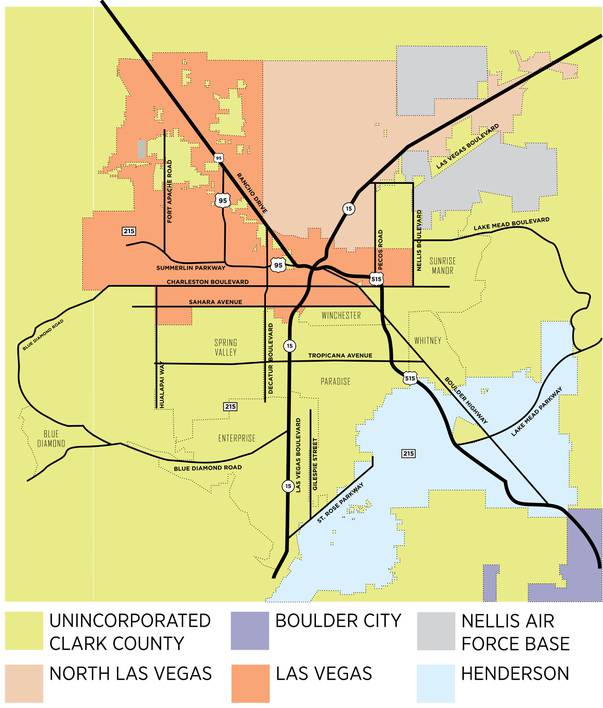
A visitor takes a selfie with the Welcome to Fabulous Las Vegas sign on September 13, 2016.
Friday, July 12, 2019 | 2 a.m.
When you enter the southernmost part of the Las Vegas Strip and are greeted by the “Welcome to Fabulous Las Vegas” sign, you can tell everyone you’ve reached Paradise — literally.
That’s because the Strip isn’t actually located within Las Vegas city limits, even though it has a Las Vegas ZIP code.
The Strip isn’t alone in this. McCarran International Airport, UNLV, the Las Vegas Convention Center and many other popular Southern Nevada tourist destinations are located in unincorporated areas within Clark County.
Winchester, Enterprise, Spring Valley, Sunrise Manor and Whitney, which are often mistakenly thought to reside within Las Vegas city limits, are actually unincorporated towns within Las Vegas Township.
And unincorporated Clark County is large. The population surpassed 1 million in 2018, almost twice the population of Las Vegas, according to the County Department of Comprehensive Planning.
In fact, if the unincorporated county were a city, it would be the largest in the state by far, said Clark County spokesman Erik Pappa.
This puts Clark County in an unusual position of power, said UNLV historian Michael Green.
“Because the county has the Strip, that gives the county government so much more power than frankly any other body in the state of Nevada,” he said. “This is the only state I know of where people give up seats on the legislature to go serve on county commission.”
In most other states, Green said, county government directly serves unincorporated populations in rural communities. Clark County, on the other hand, is much more urban.
Who services whom?
Residents who live within the boundaries of the area’s five cities—Boulder City, Henderson, Las Vegas, Mesquite and North Las Vegas—receive their municipal government services such as fire, public works and building inspections through the city.
Residents who do not live within city limits receive these services from the county. The county also manages regional services that include the airport and University Medical Center.
Residents in unincorporated areas can’t necessarily raise concerns at a Las Vegas City Council meeting, so the Clark County Commission is the equivalent of their city council.
Unincorporated communities also have their own town advisory boards. Communities such as Spring Valley, for example, have five board members and meet twice a month. They also post their agendas and minutes like any other city council.
Las Vegas and Clark County share their police department-—the Las Vegas Metropolitan Police Department. Before 1973, Clark County had five law enforcement agencies: the Clark County Sheriff’s Department, City of Las Vegas Police Department, City of North Las Vegas Police Department, City of Henderson Police Department and Boulder City Police Department. At the time, Las Vegas had the largest agency in Nevada. Many argued for incorporation of areas in the county because it had become so urbanized and should be serviced by a municipal government.
In 1973, the Nevada Legislature passed Senate Bill 340, which disbanded Clark County and Las Vegas’ law enforcement agencies and consolidated them into what is known today as Metro.
In additional to law enforcement, the Valley also shares the same flood control, school and health districts.
Annexation attempts
According to Nevada Revised Statutes, annexation can be initiated when the majority of property owners residing in an unincorporated territory desire annexation. It can also occur when an adjacent municipality deems it necessary to annex.
There aren’t substantial benefits for property owners to annex themselves into city limits, according to Green.
“Clark County government operates much like a city,” he said. “For that reason, not being in the city isn’t as big a deal here as it might be in other states.”
In addition, property owners typically don’t want to be annexed into adjacent municipalities because that adds another layer of taxes.
Clark County has 111 tax districts. The tax rate in each district is determined by the amount of money budgeted for government-provided services such as fire, police, schools and libraries.
Residents who live in unincorporated areas of the county typically pay a lower property tax rate than those who live in one of the five cities, as they avoid the added layer of a municipal tax rate.
For example, a property owner living in the North Las Vegas tax district would pay a 3.35 percent property tax rate, while one living in the unincorporated Muddy River tax district would pay 2.5 percent.
There have been several attempts by the city to annex parts of unincorporatedClark County. One of the most notable occurred in the ’50s, when Las Vegas tried to annex the Strip, seeing the separation as a huge loss in tax revenue.
Resort and casino owners weren’t keen on this move, and Flamingo owner Gus Greenbaum led a lobbying effort to thwart this attempt.
“There was also apparently a concern that if they ended up being part of the city, they’d have to donate to city campaigns,” Green said. “Heaven knows they donate now. They didn’t really escape that.”
The Clark County Commission eventually voted to create the unincorporated town of Paradise in 1950. The first town board consisted of five casino managers, and Greenbaum chaired the board.
“Greenbaum became the unofficial mayor of Paradise,” Green said. “And he was a mobster.”
Paradise was eventually divided into two townships: Paradise A and Paradise B. Paradise A was eventually renamed Winchester and Paradise B was simply named Paradise.
In 1975, Nevada passed a law that would have incorporated Paradise into the city of Las Vegas, but it was later deemed unconstitutional by the Nevada Supreme Court.
The attempt to consolidate was made again in 1977, and this time the issue was put to the voters. Voters in Las Vegas said yes. Voters in Clark County said no.
More recent annexation attempts occurred in 2000 when Henderson expanded its western fringe by annexing 5,473 acres of unincorporated Clark County. It was a joint plan between the city and county and was the city’s largest annexation since 1971, when it acquired an 8-mile stretch of what is now eastern Henderson.
In 2017, Henderson again expanded its city limits by annexing more than 35 acres northwest of Las Vegas Boulevard South and St. Rose Parkway. The city also annexed 10 acres located at Via Nobila in West Henderson.
Early last year, Las Vegas petitioned to annex small portions of Clark County encompassing 872 acres of land and 1,553 properties. All of these “county islands” are surrounded by city land. Then-City Councilman Steve Seroka expressed concern over the city providing services to nonresidents. County residents, though, were not on board with the plan.
While Nevada law gives cities the ability to annex county land they encompass, they can’t move forward if property owners object to it.
To put a stop to annexation plans, property owners representing more than half the county acreage in the proposed annexation delivered a protest petition. Residents also sent more than 1,200 protest letters.
This story originally appeared in the Las Vegas Weekly.

